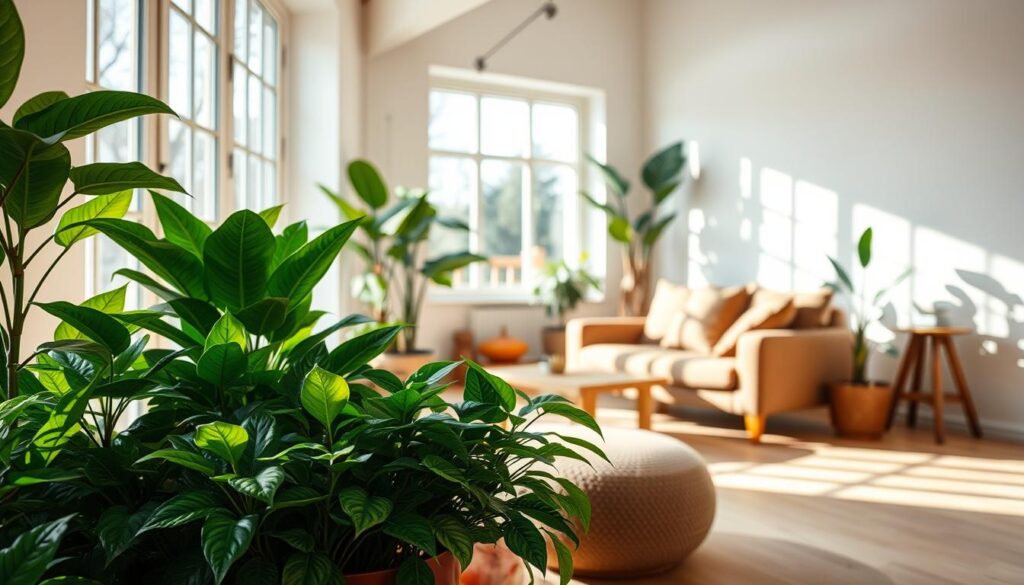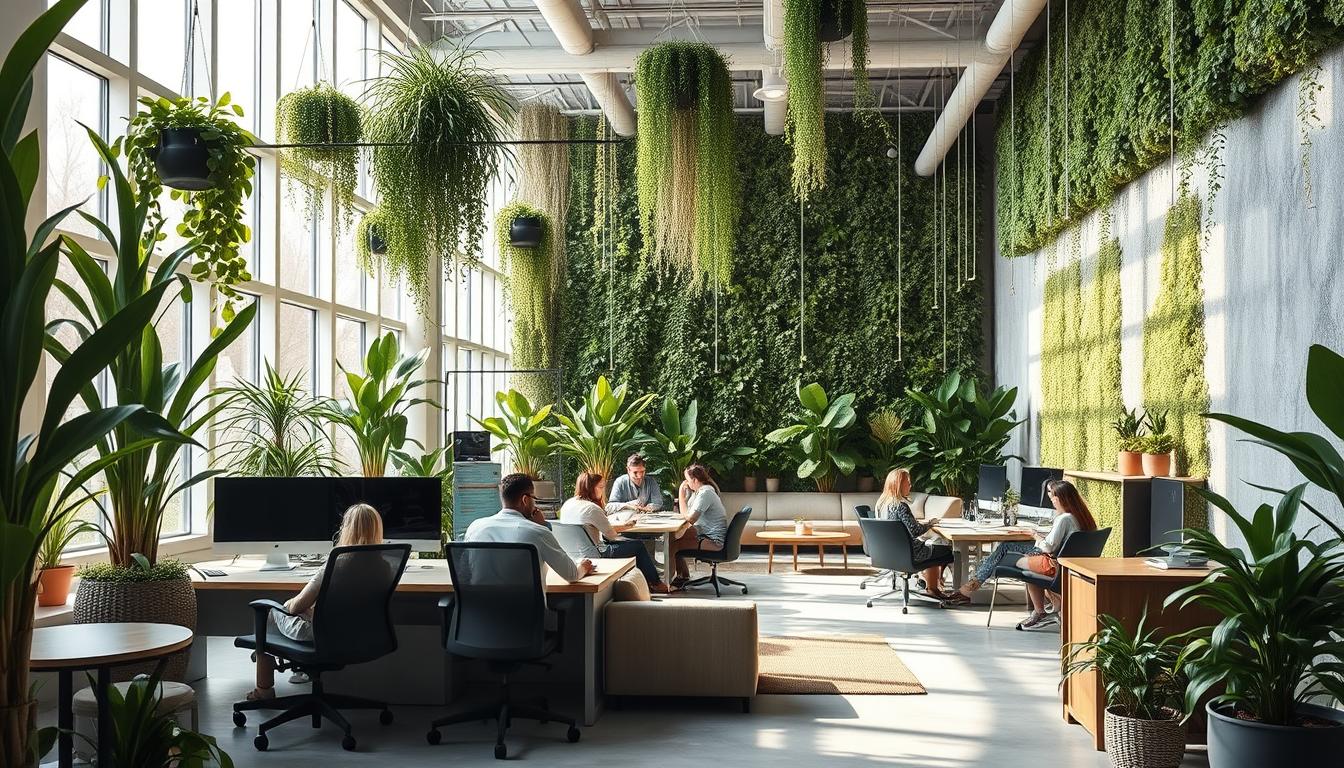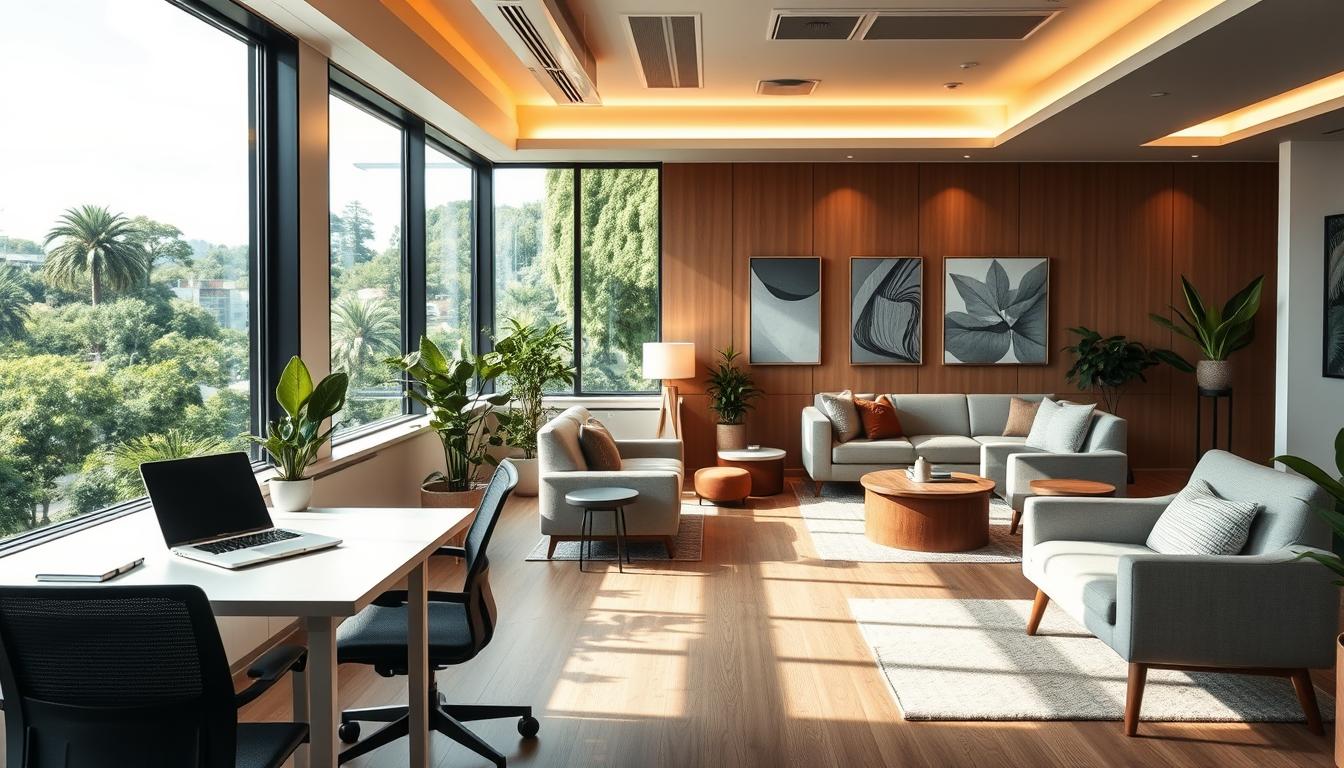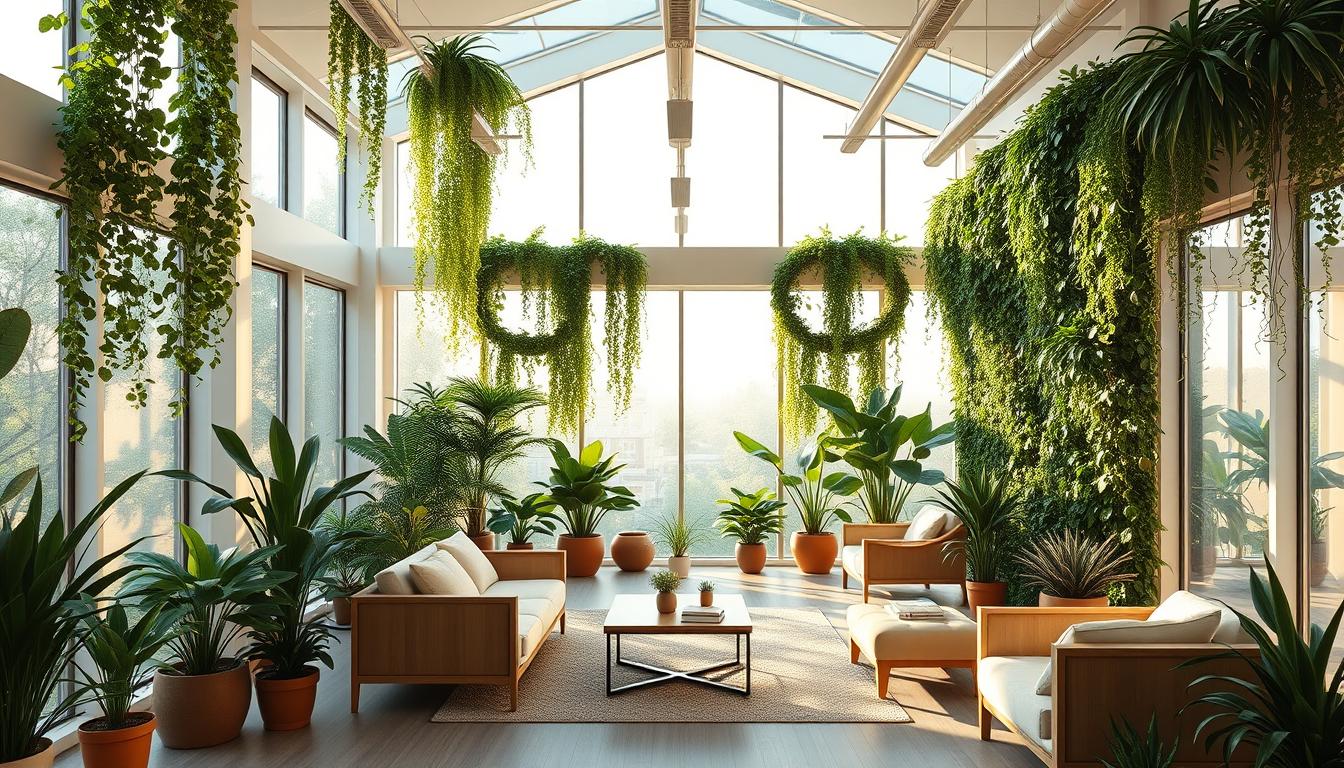Making your indoor spaces feel just right temperature-wise is key for comfort and eco-friendly living. Using groups of plants is a smart, natural way to keep the temperature and moisture levels good. Adding plants makes spaces look better and uses nature’s way to control climate. By doing this, you can make a space that’s great for health and saves energy too.
Understanding Indoor Thermal Balance
Indoor thermal balance is key for comfy living and workspaces. It highly influences how happy and productive people are. Keeping the right temperature and moisture levels makes a space healthier. This cuts down discomfort from uneven temperatures or too much humidity. Knowing how thermal balance works helps make places better for work and relaxation.
The Importance of Thermal Balance in Indoor Spaces
Thermal balance indoors does more than just make spaces comfortable. It helps people stay focused and reduces health problems from bad temperature or humidity. People in well-balanced areas feel more productive and healthier. This balance is crucial for doing daily activities well.
Factors Influencing Indoor Temperature and Humidity
Many things affect indoor thermal balance:
- External climate changes
- Building materials that keep heat in or out
- Ventilation that brings in fresh air
- Controlling heat from devices and lights
Understanding and tweaking these factors can create a balanced indoor climate. This balance makes spaces more comfy and productive.

What are Plant Clusters?
Plant clusters are groups of different plants placed together indoors. They look good and have practical uses too. They involve picking and arranging various species to enhance indoor areas.
Defining Plant Clusters in Indoor Environments
Creating plant clusters in indoor spaces means putting different plants close to each other. This makes the space look good and is healthy too. The way these plants are arranged can make the air cleaner and the space more comfortable.
The Benefits of Using Plant Clusters for Indoor Spaces
Plant clusters bring many benefits to indoor spaces. Some of these benefits are:
- Improved air quality through natural filtration of pollutants.
- Enhanced thermal comfort by regulating temperature and humidity.
- Increased moisture capture, contributing to humidity balance.
- Boosted aesthetic appeal, creating a refreshing ambiance.
Using different plants together makes these benefits even stronger. Research shows mixing various plants has positive effects on our health, showing why good plant clusters matter.
Indoor Thermal Balance via Plant Clusters Solutions
Indoor plant clusters are key for improving heat and humidity in our spaces. They make rooms more comfortable and stable, climate-wise.
How Plant Clusters Enhance Heat Distribution
Strategically placed plant clusters help spread heat evenly in a room. The plants soak up sunlight and slowly release warmth. This keeps the temperature steady and comfy.
The air gets warmer as it moves around the plants, creating a consistent climate. This natural warmth reduces the need for artificial heating.
Impact on Humidity Levels and Overall Comfort
Plant clusters also regulate humidity by releasing moisture into the air. This moisture helps keep the air quality high and the climate comfortable. Especially in dry places.
Different plants release different amounts of water, which helps keep the humidity just right. This mix makes our homes feel more pleasant.
The Science Behind Plant-Based Thermal Regulation
The way plants manage heat is vital for making indoor spaces better. Plants have special traits that impact their interaction with heat. In this part, we look at these traits and how plants keep their cool.
Thermal Properties of Various Plant Species
Plants have different ways of dealing with heat. They can absorb or let off heat well thanks to:
- Leaf Texture: Smooth leaves might reflect sunlight, while rough or fuzzy leaves soak up more heat.
- Color: Dark leaves usually take in more heat than light ones, which affects how warm or cool they are.
- Water Content: Plants with lots of water in them can keep their temperature steady by letting water evaporate.
Mechanisms of Heat Absorption and Release in Plants
Plants use a few strategies to control their temperature. The main ways they absorb heat are:
- Conduction: Heat moves through plant parts, helping them keep an even temperature.
- Transpiration: When water leaves a plant, it cools down the air around it, which helps control indoor climate.
- Radiation: Some plants can take in and let out infrared radiation, helping in their heat management.
Designing Effective Plant Clusters for Indoor Environments
Creating effective plant clusters means thinking about what they bring to indoor spaces. You must pick the right plants carefully. Some can make a room look better and help control temperature. Knowing which plants work best lets you choose those that are easy to care for and good for the indoor climate.
It’s also important to place them the right way. This makes sure they grow well and help with temperature control.
Key Considerations for Plant Selection
Choosing plants for clusters requires looking at several important factors. You should:
- Thermal Properties: Select plants known for their ability to absorb and release heat effectively.
- Care Requirements: Ensure the chosen species can thrive under the specific light and humidity conditions of your indoor environment.
- Compatibility: Choose plants with similar care routines to simplify maintenance.
Spacing and Arrangement of Plant Clusters
How you space your plants is key to their success indoors. Giving them enough room helps with air flow. This means every plant gets the light and water it needs. When placing them, keep these ideas in mind:
- Group plants with similar sizes and growth habits together to maintain visual cohesion.
- Use varying heights to create depth and visual interest while maximizing thermal benefits.
- Position clusters near windows or other light sources without overcrowding to prevent competition among plants.
Integrating Plant Clusters into Building Design
Modern buildings are bringing nature inside. This approach, known as biophilic design, is getting popular. It does more than make spaces look good. It helps control indoor temperature too. Bringing plants into cities and homes makes life better and saves energy.
Architectural Trends Emphasizing Biophilic Design
Architects are finding new ways to blend nature with our living spaces. They’re doing things like:
- Using natural stuff and patterns on the outside of buildings.
- Putting in big windows to look out over green areas.
- Adding living walls and gardens filled with different plants.
Case Studies of Successful Plant Cluster Implementations
There are many examples where adding plants to buildings has worked out great. Here are some:
- The Bosco Verticale in Milan, Italy, is two towers packed with plants. They clean the air and keep the buildings cool.
- One Central Park in Sydney has gardens going up its sides. This helps with cooling and makes the city look better.
- Seattle’s Bullitt Center is all about being green. Plants help control the temperature and make the indoors healthier.
Energy Efficiency and Cost Savings
Using indoor plant clusters is a great way to save energy and money. By adding plants inside, people can better control heating and cooling. This means they don’t have to rely so much on their heating and air conditioning systems.
Reducing Heating and Cooling Costs with Indoor Plant Clusters
Plants help keep temperatures even through natural ways, which lowers heating and cooling bills. They soak up sunlight, reducing heat in the summer and add moisture to cool the air. This means there’s less need to use air conditioners. In the winter, plants can act like insulation, helping to keep the indoor temperature steady without having to crank up the heat.
Long-Term Benefits of Sustainable Thermoregulation
Choosing plants to regulate indoor temperatures has long-lasting perks, like saving money and energy. It leads to less spending on utilities and helps the planet. Studies show using plants this way can cut energy use by up to 30%. So, the savings aren’t just for us but also benefit the environment.
Potential Challenges and Solutions
Keeping indoor plants healthy has some challenges. We must look after their care needs, light, and space properly. Understanding these points helps us take better care of our plants. This ensures they grow well and keep our air clean.
Maintenance Considerations for Indoor Plant Clusters
Caring for different types of plants can be tricky. Each plant needs specific water, soil, and food. We need to check on our plants regularly to keep them doing well. This means we have to:
- Figure out how much water each plant needs.
- Use the right fertilizers for each plant type.
- Watch out for any bugs or sickness.
Addressing Light and Space Requirements for Optimal Growth
Light and space are vital for plants to thrive. Not enough light can slow their growth and lessen the benefits they bring to our homes. Here are some ways to solve these problems:
- Put grow lights in places that don’t get much sunlight.
- Place plants that need similar amounts of light together.
- Make sure plants have enough room to grow without being too close.
Future Trends in Indoor Thermal Management
The way we manage heat and coolness indoors is changing fast. This is because of new green technologies and smart AI. We’re looking into how these changes will make our indoor spaces better while being kind to the planet.
Emerging Technologies in Plant-Based Heat Regulation
Plants are now at the forefront of keeping our indoor spaces at the perfect temperature. They can soak up heat and release water, making rooms more comfortable. Plus, new gadgets like smart sensors can check the air for changes, helping keep everything just right.
Soon, we might see green groups of plants working automatically inside our homes and offices. They will team up with technology to control the climate in a way that feels natural.
What Role Will AI Play in Managing Indoor Environments?
AI is set to change the game in how we keep our indoors comfy. It can learn from plants and the weather to make heating and cooling systems smarter. This means less energy used and a happier planet.
With AI and green tech joining forces, our indoor air will not only feel better but also do good for the earth. We’re heading towards having spaces that understand and adjust to our needs automatically.
Conclusion
Adding plant clusters indoors can make a big difference. They make places look good and help control temperature and humidity. This green choice is good for us and the planet, making our homes better places to live.
Using plants indoors saves energy and money over time. Architects and designers can make our homes greener by using them. This way, we live better while taking care of the earth.
We need to see how great plants are for our homes. They bring comfort and are eco-friendly. By choosing to use them now, we make our future indoors healthier and more pleasant.



